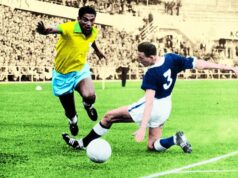Soccer is a physically demanding sport that places pro athletes on the fast track to present or future joint issues. These problems catch up regardless if the player has a history of injuries or not. They are the result of repetitive activities, like kicking the ball and concomitant forces that induce early degeneration. Weight gain after retiring only aggravates the problem and potentially faces athletes with a wide array of conditions. Luckily, there are many things you can do in order to keep your joints healthy.

Weakest links
It does not come as a surprise that weight-bearing joints such as the knee or hip are impacted the most. There is quite a bit of fast running and changing direction in soccer, and it seems that the strain on these joints cannot be avoided. For instance, soccer players are 10 times more likely to develop hip arthritis at one point in their life. Knee joints are prone to injury as well, since they are almost exclusively composed of soft tissue and small muscles.
Furthermore, ankles are another body part under siege. The demands of fluid movement make ankle injuries account for 20% of all sports injuries. Still, they are just one piece of the puzzle, because in general, leg and foot injuries account for 50-80% of all injuries. However, this is not to say that joint problems are inevitable, merely that there is an increased risk.
Mind your steps
Risk awareness is the first step towards well-being. First off, sprains and strains are among the most common lower extremity injuries. Soccer players often experience anterior cruciate ligament (ACL) sprains in the knee and cartilage tears. These injuries may require surgery. On the other hand, there are injuries such as fractures and concussions that occur as a result of a direct blow to the body.
Next, we come across lower extremity injuries: shin splints, Achilles tendinitis, calf muscle, strains, and patellar tendinitis. They are probably the most common overuse conditions. Some of these problems require only a couple of days of rest. Still, in case the pain persists and does not gradually wane, a physician should examine the spot for stress fractures.
It goes without saying that training activities should cease until the injury is evaluated and treated. Most injuries are minor and involve a short treatment with simple tools like rest, ice, and elevation. This does not mean they can be ignored and disregarded. Pushing through the pain is never a good idea, as it can add fuel to the fire and cause more serious problems.
In the clear
Thus, periods of inactivity should be followed by gradual progress and return to full-contact play. Strength and agility training, as well as aerobic conditioning, can help the player recover. Some players also take glucosamine in order to protect the joints. It acts as a building block for cartilage and synovial fluid and thus supplements that contain it have a positive impact on damaged joints.
Additionally, in instances of ankle problems and injuries, ankle support plays a major role. Canvas lace-ups and neoprene sleeves restrict side-to-side rolling motions, but still allow for the free flow of movement while running and walking. Ankle braces and tapes can be worn during training sessions and even games. They are often part of a supervised rehabilitation program that includes up to 10 weeks of balance training exercises.
At last, bear in mind that injury prevention is the best approach to ensure good health and the longevity of any career. There is a multitude of best practices to adhere to: use appropriate equipment, be aware of poor field conditions and environmental recommendations, hydrate regularly, steer away from over-training, and maintain a high fitness level. In the soccer world, carelessness can cost you dearly – an arm and a leg, literally.
Play it safe
Constant pounding from the years and years of training sessions and matches takes a toll on the joints. Sooner or later, problems catch up with every player. On a brighter note, though, it is within your power to prevent or mitigate joint problems down the road. To stay on the safe side, you have to take burnout, pain, and strain seriously. Get back in the game in due time and you will do it with flying colors.






